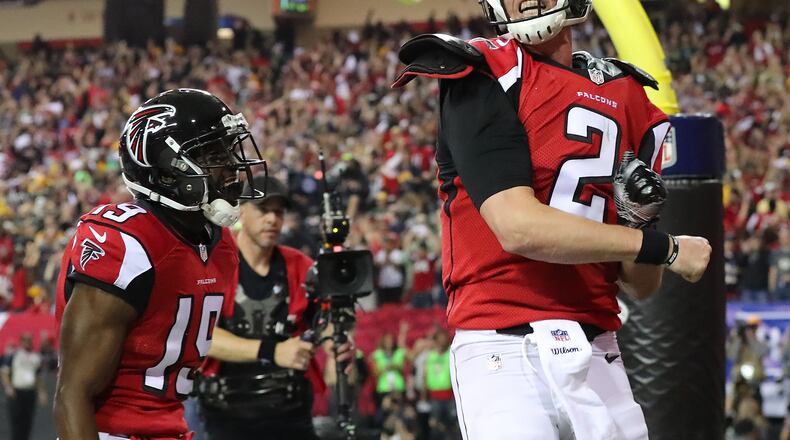This time, the Falcons wouldn’t squander a prime chance to return to the Super Bowl. This time, the Falcons finished in the NFC Championship game.
In their final game at the Georgia Dome, the Falcons beat the Packers 44-21 on Sunday. The Falcons advanced to play in the Super Bowl on Feb. 5 in Houston against the winner of the AFC Championship game later Sunday between the Patriots and Steelers.
The Falcons will make their second Super Bowl appearance in franchise history, 18 years after their first. They were on the verge of making the 2013 Super Bowl when they led the 49ers 17-0 in the NFC title game at the Georgia Dome but faded to a 28-24 loss.
The Falcons were back in the playoffs for the first time since that game and again ran out to an early lead in the conference championship game. After the Falcons gained a 17-0 lead against the Packers, Fox television broadcast showed highlights of them blowing that same advantage against the 49ers.
But the Falcons kept going. They led 24-0 at halftime, forced a Packers three-and-out on the first possession of the second half and then saw All-Pro wide receiver Julio Jones score on a sensational 73-yard catch-and-run for a 31-0 lead.
The Falcons last went to the Super Bowl during the 1998 season and they lost to the Broncos 34-19 in Miami. The Falcons returned to the NFL’s championship game with a dominating defeat of the Packers.
Here are five key elements to the victory:
1. Even hobbled, Julio Jones was best player on field
Jones has dealt with nagging left foot and toe injuries for more than a month but said he’d be ready to go for Sunday, noting that he’s learned to play through various injuries throughout his career.
Jones did it again. He was in and out of the game and appeared to be favoring the foot but still had nine catches for 180 yards and two TDs, including the electrifying 73-yard score.
“I know he wasn’t feeling his best but he’s a warrior and he went out and competed for us,” Falcons quarterback Matt Ryan said.
2. Key defensive plays slowed streaking Packers
With their offense humming along, the Falcons only needed a few key plays from their defense. They got them against what was probably the NFL’s second-best offense over the final half of the season.
The Falcons shut out the Packers in the first half by making key plays to extinguish two prime scoring chances.
“We needed to keep pace with those guys and felt confident coming in here we could score points,” Packers coach Mike McCarthy said. “We fell behind and then we got into a game you just don’t want to play, especially in this stadium.”
After the Falcons took a 7-0 lead, Packers quarterback Aaron Rodgers quickly led them to within scoring range with completions of 27 and 15 yards to Jordy Nelson. But the Falcons forced a third down at their 23-yard line and linebacker Deion Jones came free on a blitz and hit Rodgers to force a throw away. Mason Crosby then missed a 41-yard field goal attempt to end the drive.
Rodgers rallied the Packers again after the Falcons went ahead 10-0. Consecutive passes of 17 and 22 yards to Randall Cobb and a third-down conversion to Jared Cook quickly got the Packers near the red zone again. Fullback Aaron Ripkowski dragged along several Falcons defenders but Jalen Collins stripped him of the ball and recovered the fumble in the end zone to extinguish another prime scoring chance for Green Bay.
3. Falcons’ offense continued to fire early
The Falcons scored a TD on their opening possession for the eight straight game and did so in a way that illustrates why they are so difficult to defend. As he has all season, Ryan spread the ball around to multiple targets.
Tight end Austin Hooper converted a third down with a catch. Jones made a difficult catch of Ryan’s low pass to covert another third down. Wide receiver Mohamed Sanu caught a 13-yard pass on third-and-12 with Jones out of the game. Fullback Patrick DiMarco’s 31-yard catch down to Green Bay’s 5-yard line was aided by Jones clearing out the coverage.
Ryan finished the drive by flipping an underhanded pass to Sanu for a 2-yard TD.
“We definitely had them shook early on,” Jones said.
4. Aggressive pass rush got to Rodgers
In the days before the game, Falcons coach Dan Quinn said his team’s defense tries to mix up their pass-rush looks against mobile quarterbacks such as Rodgers. After Rodgers frustrated the Falcons by making several plays outside of the pocket during an Oct. 30 Green Bay loss at the Georgia Dome, they focused on keeping him in the pocket in the rematch.
“We didn’t get to him all the time but we corralled him,” Falcons linebacker Phillip Wheeler said.
Even while keeping Rodgers in the pocket, the Falcons sometimes sent extra defenders to pressure him so he couldn’t stand unhurried.
There was Jones’ hit on Rodgers to force the throw away before Crosby’s miss. Later in the half cornerback Brian Poole blitzed and hit Rodgers on a third down, forcing him to check down to a receiver short of the first-down marker. Poole walloped Rodgers again on Green Bay’s final drive before halftime. Rodgers completed the pass but paid the price.
The Falcons sacked Rodgers twice and hit him seven times.
5. Rookies help contain Cook
Two Falcons rookies, safety Keanu Neal and linebacker De’Vondre Campbell, had a new challenge: help to limit Cook, a North Gwinnett High product. Cook didn’t play during Green Bay’s regular-season game against the Falcons because of an injury. He was riding high for the rematch after his toe-tapping catch near the sideline set up the game-winning field goal against the Cowboys last weekend.
After Cook had six catches for 103 yards and a TD against the Cowboys, Neal and Campbell helped make sure he had little impact. Neal made a key play on Green Bay’s first drive when he broke up a pass in the end zone intended for Cook. The drive ended with Crosby’ s missed field goal.
Cook caught a 1-yard TD pass with the game essentially decided in the fourth quarter.
About the Author
Keep Reading
The Latest
Featured


